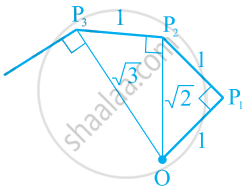Advertisements
Advertisements
प्रश्न
Prove that the following are irrational.
`6+sqrt2`
उत्तर
`6+sqrt2`
∴ We can find two co-prime integers a and b such that `6 + sqrt2 = a/b`, Where b ≠ 0
∴ `a/b - 6 = sqrt2`
or `sqrt2 = (a/b - 6)`
= `(a - 6b)/b`
From (1), `sqrt2` is a rational number, which contradicts the fact that `sqrt2` is an irrational number.
∴ Our supposition is wrong.
= `6 sqrt2` is an irrational number.
APPEARS IN
संबंधित प्रश्न
Examine, whether the following number are rational or irrational:
`(sqrt2-2)^2`
Identify the following as rational or irrational number. Give the decimal representation of rational number:
`sqrt4`
In the following equation, find which variables x, y, z etc. represent rational or irrational number:
y2 = 9
Give an example of two irrational numbers whose:
difference is an irrational number.
Give an example of two irrational numbers whose:
product is an rational number.
Give an example of two irrational numbers whose:
quotient is an irrational number.
Classify the numbers 3.121221222 as rational or irrational:
Prove that `1/sqrt (3)` is irrational.
Prove that (4 - 5`sqrt(2)` ) is irrational.
Find the square of : √3 + √2
State whether the following number is rational or irrational
`(5 - sqrt(5))^2`
Check whether the square of the following is rational or irrational:
`sqrt(2) + sqrt(3)`
Compare the following:
`root(3)(48) and sqrt(36)`
Represent the number `sqrt(7)` on the number line.
Which of the following is not irrational?
Number of rational numbers between 15 and 18 is finite.
Classify the following number as rational or irrational with justification:
0.5918
Insert a rational number and an irrational number between the following:
3.623623 and 0.484848
Show that the product of a non-zero rational number and an irrational number is an irrational number.
Classroom activity (Constructing the ‘square root spiral’): Take a large sheet of paper and construct the ‘square root spiral’ in the following fashion. Start with a point O and draw a line segment OP1 of unit length. Draw a line segment P1 P2 perpendicular to OP1 of unit length. Now draw a line segment P2 P3 perpendicular to OP2. Then draw a line segment P3 P4 perpendicular to OP3. Continuing in this manner, you can get the line segment Pn–1Pn by drawing a line segment of unit length perpendicular to OPn–1. In this manner, you will have created the points P2, P3,...., Pn,.... ., and joined them to create a beautiful spiral depicting `sqrt2, sqrt3, sqrt4,` ...

